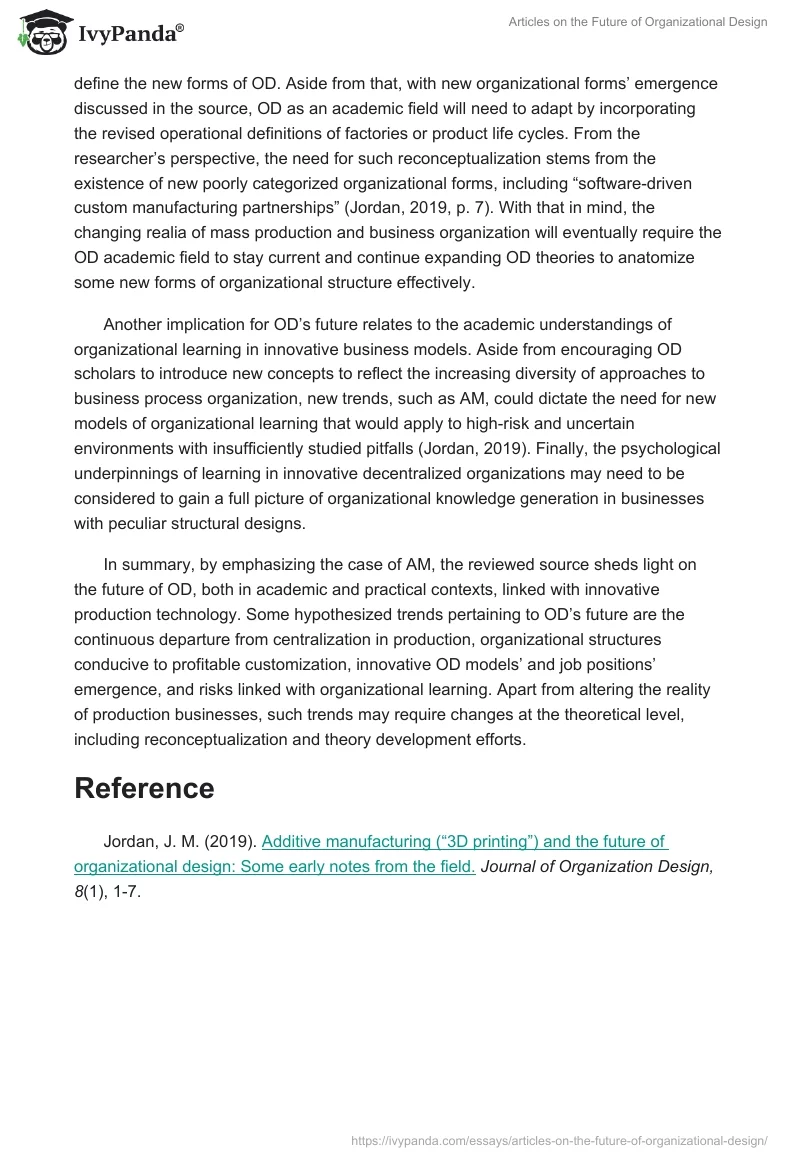Organizational design (OD) involves the exploration of connections between organizational efficiency and models promoting alignment between internal organizational processes, structures, human resources, and values in the psychological dimension. Multiple emerging technologies are capable of altering business owners’ structuring-related preferences, thus affecting the future of OD. This essay seeks to summarize and analyze Jordan’s (2019) unstructured literature review on the implications of additive manufacturing (AM) for OD.
By combining previous researchers’ insights with qualitative notes from the manufacturing field, the author argues that AM, widely known as 3D printing, could join the ranks of previous inventions, including the introduction of hydraulic power and assembly lines, in revolutionizing OD. There are four central themes that explain the practice’s possible implications for OD. Firstly, AM’s widespread use will increase managers’ decision-making freedom in determining the degree of productive capacity’s centralization or decentralization (Jordan, 2019). Secondly, in supply networks driven by demand, AM will enable a smarter and more profitable mass customization of goods (Jordan, 2019). Thirdly, the so-called “additive-native organizations” can emerge, giving rise to new OD models, the demand for agile generalist specialists, and sunk costs’ reduction (Jordan, 2019, p. 5). Finally, the most interesting point touching upon the psychology dimension of OD is that AM can become a hindrance to organizational learning due to being a risky approach with unclear returns that also involves “a departure from established norms” (Jordan, 2019, p. 1). These four hypotheses illustrate the possible OD-related large-scale reverberations of only one innovative production practice.
The source contributes to the discussion of OD’s future in many ways by reflecting larger trends and proposing new directions for OD research. To start with, AM’s supposed ability to alter centralization-related decisions deserves close attention. Jordan’s (2019) hypothesis aligns with a larger body of OD research, stating that the replacement of top-down hierarchies with flexible, non-hierarchical, and decentralized organizations, which is the already existing phenomenon, will continue in the future and define the new forms of OD. Aside from that, with new organizational forms’ emergence discussed in the source, OD as an academic field will need to adapt by incorporating the revised operational definitions of factories or product life cycles. From the researcher’s perspective, the need for such reconceptualization stems from the existence of new poorly categorized organizational forms, including “software-driven custom manufacturing partnerships” (Jordan, 2019, p. 7). With that in mind, the changing realia of mass production and business organization will eventually require the OD academic field to stay current and continue expanding OD theories to anatomize some new forms of organizational structure effectively.
Another implication for OD’s future relates to the academic understandings of organizational learning in innovative business models. Aside from encouraging OD scholars to introduce new concepts to reflect the increasing diversity of approaches to business process organization, new trends, such as AM, could dictate the need for new models of organizational learning that would apply to high-risk and uncertain environments with insufficiently studied pitfalls (Jordan, 2019). Finally, the psychological underpinnings of learning in innovative decentralized organizations may need to be considered to gain a full picture of organizational knowledge generation in businesses with peculiar structural designs.
In summary, by emphasizing the case of AM, the reviewed source sheds light on the future of OD, both in academic and practical contexts, linked with innovative production technology. Some hypothesized trends pertaining to OD’s future are the continuous departure from centralization in production, organizational structures conducive to profitable customization, innovative OD models’ and job positions’ emergence, and risks linked with organizational learning. Apart from altering the reality of production businesses, such trends may require changes at the theoretical level, including reconceptualization and theory development efforts.
Reference
Jordan, J. M. (2019). Additive manufacturing (“3D printing”) and the future of organizational design: Some early notes from the field.Journal of Organization Design, 8(1), 1-7.


